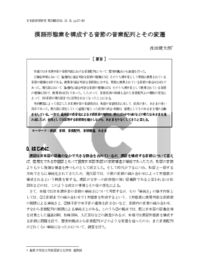漢語形態素を構成する音節の音素配列とその変遷
number of downloads : ?
Use this link to cite this item : https://ir.lib.shimane-u.ac.jp/49101
| ID | 49101 |
| File | |
| language |
jpn
|
| Title Transcription | カンゴ ケイタイ ソ ヲ コウセイ スル オンセツ ノ オンソ ハイレツ ト ソノ ヘンセン
|
| Title Alternative (English) | The Syllable Phonotactics that Construct Sino-Japanese Morphemes and Their Transformation
|
| Author | |
| Description | 本稿では日本漢字音の音節内部における音素配列について、歴史的観点から調査を行った。12世紀中頃において、論理的に結合可能な音節の種類は742、そのうち漢字音として実際に使用されている音節の種類は400である。使用率(結合可能な音節数に対する、実際に使用されている音節の割合)は54%であった。現代語において、論理的に結合可能な音節の種類は474、そのうち漢字音として使用されている音節の種類は295で、使用率は62%であった。したがって、音素成員の削減も含めた音素配列上の規則の変化によって、105音節が現代語までに区別されなくなったことになる。
外的要因によって成立した日本漢字音の音韻体系は、和語の音韻体系に比して、成員が多く、あきまの多い体系であった。現代語に変化していく過程で起こった成員の統合·削減は、結果としてそのあきまを埋める働きをしている。一方で、連母音の長音化によるオ段長音の増加は、例えば/eJ/や/aR/などの新たなあきまを生み出したが、全体としては区別する音節数を縮小しながら、あきまを少なくしてきたと言える。 |
| Description Alternative | A high percentage of Japanese language words—particularly nouns—are Sino-Japanese. The simplicity of the phonotactics that construct Sino-Japanese morphemes has been pointed out by many scholars heretofore. This paper considers from a historical perspective the syllable phonotactics that construct Sino-Japanese morphemes. In the mid-12th century, there were 742 theoretically combinable syllables, 400 of which were actually used as Sino-Japanese. The usage rate (the ratio of actually used syllables to the number of combinable ones) was 54%. In the contemporary Japanese language, there are 474 theoretically combinable syllables, 295 of which are used as Sino-Japanese. The usage rate is 62%. This means that 105 syllables have come to be no longer distinguished between due to phonotactic rule changes, including a reduction in the number of phoneme members.
The Sino-Japanese phonetic system, which came into existence based on external factors, has many members and distribution holes compared to the native Japanese one. The combining of and reduction in phoneme members that occurred in the process of the contemporary Japanese language emerging has functioned to fill these distribution holes. On the other hand, while the increase in the long "o" due to the lengthening of sequential vowels has given rise to, for example, new distribution holes such as /eJ/ and /aR/; overall it has reduced the number of them while lessening the number of syllables that are distinguished between.wed as that the "ability for culture education" was a requirement of a NT and was particularly important in TT. |
| Subject | 漢語
音節
音素配列
音節構造
あきま
Sino-Japanese
syllable
phonotactics
syllabic structure
distribution holes
|
| Journal Title |
日本語敎育硏究
|
| Volume | 33
|
| Start Page | 37
|
| End Page | 56
|
| Published Date | 2015-10-31
|
| Publisher | 韓国日語教育学会
|
| Publisher Transcription | カンゴ ニチゴ キョウイク ガッカイ
|
| Publisher Aalternative | 한국일어교육학회
|
| NII Type |
Journal Article
|
| Format |
PDF
|
| Relation | |
| Text Version |
出版社版
|
| Gyoseki ID | e29591
|
| OAI-PMH Set |
Faculty of Law and Literature
|
